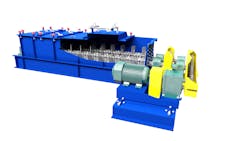Seven overlooked settings in which mixers can offer benefits
Industrial mixers are lauded for the capabilities they can bring to industrial process settings. For manufacturers of chemicals, minerals and many other products, mixers have the power to expertly blend solid-and-solid or solid-and-liquid feed components into homogeneous mixtures.
Often forgotten, however, is the extent to which the ability to homogeneously blend disparate feed components goes far beyond simple mixing. This article covers seven overlooked settings in which mixers can bring critical process advantages to producers of all kinds. Note that, while this article references pin mixers and pugmill (or paddle) mixers specifically, many of the same principles apply across other types of industrial mixers.
Preconditioning material in a larger agglomeration/granulation process
Many agglomeration (particle-size enlargement) processes use a preconditioning step to homogenize feedstock prior to granule formation. This preconditioning step accomplishes two key objectives:
1. Blending the feedstock to encourage optimal granule formation. In wet granulation processes, granule formation relies on the ability to gather particles into a mass that will hold together, forming the granule’s core or nucleus, onto which additional layers will accumulate. The propensity for this to happen is highly dependent on the feed’s moisture content, which allows capillary forces to hold particles together. As such, the powdered component and liquid binder must be uniformly blended for adequate granule formation to occur.
2. Blending the feedstock for maximum uniformity in finished granules. In both wet and dry granulation, a uniform final product requires that the components are first uniformly blended together. Ultimately, mixing prior to granulation ensures that each finished granule contains the entire formulation as intended, rather than varying ratios of each component. In wet granulation, uniform blending of the solid and liquid feedstocks also influences the ability to reach the desired crush strength in the end product. If feed components are not homogeneously combined, crush strength could vary significantly from one granule to the next.
For these reasons, a preconditioning mixer is often included prior to a briquetter, disc pelletizer, or granulation drum.
For the same reasons, many agglomeration processes may benefit significantly from a preconditioning mixer, even if one is not technically required. Potential benefits include a more uniform product, increased production, reduced binder requirement and more. This is often the case when pelletizing powdered limestone and gypsum into granular soil amendment products; pin mixers have become near standard in these production lines.
Homogenizing feedstock prior to heat treatment
As with agglomeration, some heat treatment operations also require a homogeneous feedstock, and the more uniform the blend of components going into the system, the more uniform the product exiting the system. This can have a variety of implications depending on the process and material.
An excellent example of the importance of mixing in heat treatment is the processing of copper concentrates prior to smelting. To maximize copper production and minimize inefficiencies, copper producers can combine a number of byproducts and materials with the concentrates in a pugmill mixer prior to smelting. Along with the concentrates, this typically includes flux, reverts, matte recycle, and dust recycle.
By homogenizing and dedusting the material (the components are combined with water), copper producers are able to improve smelting efficiency by reducing the amount of material that can become entrained in the process gas and carried out of the system. The uniform mixture also helps to maximize recovery by ensuring that the material is equally exposed to the heat.
Another example can be found in the glass industry, where glass batch is conditioned in a mixer prior to the melting furnace to create a uniform glass mixture. Conditioning also dedusts the material so that fines do not become entrained in the furnace and carried out with the exhaust gas, which further helps to keep the desired formulation intact.
Dedusting materials
The ability to homogeneously blend a liquid and solid feedstock also makes the mixer an excellent dedusting device. Whether for a finished product, raw feed, or intermediary material, a mixer can be incorporated into the process flow to mitigate the many issues associated with dust which, depending on the material, include:
- Inflated housekeeping and labor costs
- Reduced equipment lifespan
- Lost product
- Difficulty in handling, transporting and applying product
- Slip and trip hazards
- Inhalation risk
While both pin and pugmill mixers are effective for dedusting, pin mixers have the added benefit of micro-pelletizing material. In addition to homogeneously blending liquid and solid feed components into a uniform mixture, the pin mixer’s intense spinning action can produce small, uniform granules in the range of 20 to 60 mesh. This has made pin mixers a favored tool in industries working with ultra-fine materials such as carbon black, coal, pet coke, fly ash and even biochar.
Conditioning materials for landfill
Producers are often faced with the need to condition their material prior to landfill deposition. This may be to address the potential for a dusty material to become windblown, the need to treat an otherwise-caustic material, to improve the economics of transporting a sludge, or to assist in minimizing liquids from leaching.
To alleviate these issues, producers can condition their material in a way that addresses their specific challenge — whether that be through dedusting, mixing in an additive to stabilize a material that would otherwise leach, incorporating dry material to reduce the moisture content of a sludge, or otherwise.
In some cases, producers can optimize their waste management efforts by combining materials. Such is the case with fly ash and filter cake sludge; the materials can be mixed together to avoid the dust issues associated with fly ash and the handling challenges associated with sludge.
Facilitating reuse and recovery
Process byproducts and waste materials are often deemed unusable simply because of the form they are in. This results in potential resources being unnecessarily landfilled and removed from the supply chain. Converting these “wastes” into a more usable form can keep the materials in the resource pool and allow producers to recover their value.
This is the case with many baghouse dusts, which often contain valuable components that can be recovered or repurposed. Such materials include:
- Coal and coke products
- Steel mill byproducts
- Fly ash
- Alumina
- Smelter flue dust
- Ferroalloy dust
- Lead oxide
- Ore dust and fines
Simply mixing and/or micro-pelletizing these materials quite often makes them amenable to recovery processes or reintroduction to their originating processes.
Coating applications
Mixers may also be used to distribute a coating product such as an anti-caking or anti-dusting additive throughout a bed of granules. Pugmill mixers work particularly well in these settings. Their gentle folding and kneading action encourages uniform distribution of the dispersant throughout the material bed without excessive product degradation.
This technique is widely used to finish potash fertilizers produced via compaction granulation. The granules are fed into a pugmill mixer and sprayed with a small amount of water (in this setting, the technique is known as “glazing”). The gentle tumbling action evenly distributes the water throughout the material bed.
Improving flowability
Flowability is critical when handling and processing powders and bulk solid materials and often determines whether a process runs smoothly or suffers from frequent upsets. Good flowability improves metering and dosing, streamlines production, helps to prevent equipment clogging and much more.
A mixer’s ability to blend solid and liquid components also makes it ideal for improving the flowability of both dusts and sludges. Dusts can be upgraded into rough granules, which are inherently more flowable than fine particles, and sludges can be converted to rough agglomerates with reduced moisture and improved flowability.
Knowing when a mixer can solve the problem
While it is not always clear whether adding a mixer to a process will solve a given production or material problem, the potential to improve process efficiency, increase production, recover value, and operate more sustainably, among other benefits, can be powerfully motivating.
Producers interested in evaluating the addition of a mixer to their process have a few options available to them. On a small scale, they may experiment internally with bench-top trials to determine how their specific material responds to mixing and assess whether mixing will help to meet their process goals.
Similarly, many mixing equipment suppliers offer small-scale rental units for conducting research and development work on a larger scale with more representative equipment.
Producers can also take advantage of testing facilities such as the FEECO Innovation Center, where both pin and pugmill mixers can be trialed at pilot scale to assess their effectiveness in a given application. The facility can also produce sample batches of material for further evaluation.
Such testing can help to evaluate how a material responds to mixing, the most suitable approach to mixing for the given application, key process variables, and more.
Chris Kozicki is a process sales engineer specializing in tumble-growth agglomeration and has been with FEECO for over 30 years. Kozicki is an active member of the agglomeration community and former president of the Institute for Briquetting and Agglomeration (IBA).
Carrie Carlson is a technical writer who has been with FEECO for over a decade. She works closely with engineers and process experts to turn complex ideas into easy-to-understand literature.
FEECO International
About the Author
Chris Kozicki
Process Sales Engineer at FEECO
Chris Kozicki is a Process Sales Engineer specializing in tumble-growth agglomeration and has been with FEECO for over 30 years. Chris is an active member of the agglomeration community and former president of the Institute for Briquetting and Agglomeration (IBA).
Carrie Carlson
Technical Writer, FEECO
Carrie Carlson is a technical writer who has been with FEECO for over a decade. She works closely with engineers and process experts to turn complex ideas into easy-to-understand literature.



